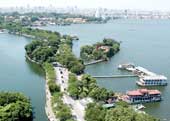 HANOI HANOI
has an elegance, a grace, unlike any other city in Asia . It is a stately capital, an old grande dame whose worn beauty hints at untold stories - a secret past. It is a city that invites nostalgia, just as it invites questions: Who else has stopped beneath this spreading banyan tree? Who once lived in that proud colonial villa? Who lives there now? In the wide, tree-lined boulevards of the French Quarter, the past is palpable. History clings to the sun-drenched walls like moss.
HALONG BAY
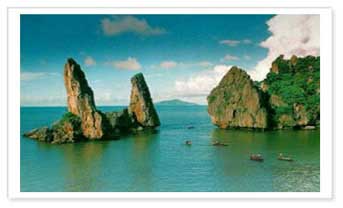 Imagine a mystical landscape of turquoise water sprinkled with thousands of jagged, limestone islands. The Halong archipelago is one of the world's natural wonders -a bay with more than 3,000 islands, which time, wind and waves have sculpted into fantastic shapes. The best way to appreciate this magical scene is from a boat, cruising between these karst cliffs, which loom like fairy-tale castles, complete with rocky spires and hidden caves. Imagine a mystical landscape of turquoise water sprinkled with thousands of jagged, limestone islands. The Halong archipelago is one of the world's natural wonders -a bay with more than 3,000 islands, which time, wind and waves have sculpted into fantastic shapes. The best way to appreciate this magical scene is from a boat, cruising between these karst cliffs, which loom like fairy-tale castles, complete with rocky spires and hidden caves.
HUE
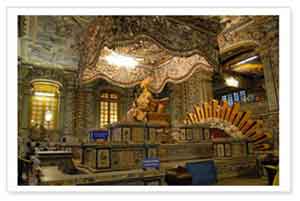 In the 1920s, a French visitor to the Imperial City of Hue described the scene as follows: " Perfume-bearers in royal-blue, fan-bearers in sky-blue waving enormous yellow feather fans ,musicians and guardsmen and ranks of mandarins in their curious hats and gorgeous, purple-embroidered dragons, kow-towing down, down on their noses amidst a cloud of incense- and all in a setting of blood-red lacquer scrawled with gold". In the 1920s, a French visitor to the Imperial City of Hue described the scene as follows: " Perfume-bearers in royal-blue, fan-bearers in sky-blue waving enormous yellow feather fans ,musicians and guardsmen and ranks of mandarins in their curious hats and gorgeous, purple-embroidered dragons, kow-towing down, down on their noses amidst a cloud of incense- and all in a setting of blood-red lacquer scrawled with gold".
SAPA
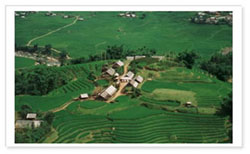 Beaming Red Dao women crowd the front steps of Sapa's gothic, grey stone church and pull strips of colorful embroidered fabric from their woven rattan backpacks. Their huge, red headdresses bob as they call to passers-by. Ethnic minority people in various styles of traditional dress -indigo tunics and leggings, elaborate pleated skirts, silver-studded jackets - stroll up from the valley, all bound for Sapa's bustling weekend market. They carry bundles of produce and lead pack-ponies through the village's steep streets. Beaming Red Dao women crowd the front steps of Sapa's gothic, grey stone church and pull strips of colorful embroidered fabric from their woven rattan backpacks. Their huge, red headdresses bob as they call to passers-by. Ethnic minority people in various styles of traditional dress -indigo tunics and leggings, elaborate pleated skirts, silver-studded jackets - stroll up from the valley, all bound for Sapa's bustling weekend market. They carry bundles of produce and lead pack-ponies through the village's steep streets.
DANANG
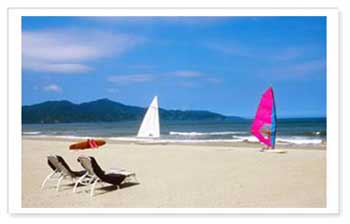 Gateway to world Heritages, just a short drive from Danang lay four UNESCO-listed World Heritage Sites: the former imperial city of Hue (2 hours), the ancient ‘Silk Road' trading port of Hoi An (30 minutes away), the spiritual centre of the Champa civilization, My Son (90 minutes) and the mystical Phong Nha Caves in Quang Binh province (3 hours), considered by some an access to the inner earth! Gateway to world Heritages, just a short drive from Danang lay four UNESCO-listed World Heritage Sites: the former imperial city of Hue (2 hours), the ancient ‘Silk Road' trading port of Hoi An (30 minutes away), the spiritual centre of the Champa civilization, My Son (90 minutes) and the mystical Phong Nha Caves in Quang Binh province (3 hours), considered by some an access to the inner earth!
PHNONG NHA - KEBANG
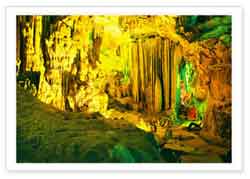 Geological processes through ages have bestowed upon Viet Nam large area of limestone. Phong Nha - Ke Bang is representative of such a limestone landscape. Located where the majestic Truong Son range starts, Phong Nha-Ke Bang (Quang Binh province) has within it, numerous inter-linking systems of caves, together with a number of very distinctive underground rivers and streams. Geological processes through ages have bestowed upon Viet Nam large area of limestone. Phong Nha - Ke Bang is representative of such a limestone landscape. Located where the majestic Truong Son range starts, Phong Nha-Ke Bang (Quang Binh province) has within it, numerous inter-linking systems of caves, together with a number of very distinctive underground rivers and streams.
NHA TRANG
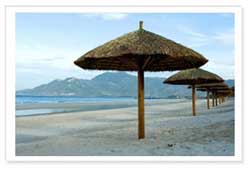 A child with a box of crayons couldn't have created a more colorful place than Nha Trang . Surrounded by steep, dark green hills, the city hugs a long curve of yellow beach and a bay as blue as a fancy cocktail. Everywhere you look there are splashes of color: yellow colonial mansions, red flame trees, the whirling hues of the Ferris wheel and the children's amusement park, vendors selling balloons and beach toys, beach umbrellas in bold, primary colors... A child with a box of crayons couldn't have created a more colorful place than Nha Trang . Surrounded by steep, dark green hills, the city hugs a long curve of yellow beach and a bay as blue as a fancy cocktail. Everywhere you look there are splashes of color: yellow colonial mansions, red flame trees, the whirling hues of the Ferris wheel and the children's amusement park, vendors selling balloons and beach toys, beach umbrellas in bold, primary colors...
DALAT
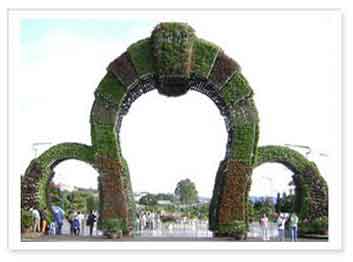 With its green, rolling hills, misty lakes and fragrant pine forests, Dalat is Vietnam's most romantic destination. Set at an elevation of 1,475 metres, surrounded by forests, coffee plantations and gardens, Dalat, is often called the "City of Eternal Spring". The name is apt. While the surrounding lowlands bake in summer heat, Dalat's temperatures hover between a cool 15 and 24 degrees Celsius. With its green, rolling hills, misty lakes and fragrant pine forests, Dalat is Vietnam's most romantic destination. Set at an elevation of 1,475 metres, surrounded by forests, coffee plantations and gardens, Dalat, is often called the "City of Eternal Spring". The name is apt. While the surrounding lowlands bake in summer heat, Dalat's temperatures hover between a cool 15 and 24 degrees Celsius.
HOCHIMINH
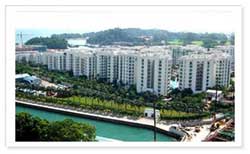 Ho Chi Minh City never sleeps. Everywhere you look there is color and movement. Vendors engulfed in bright bubbles of balloons or pushing carts heaped with wares; flocks of schoolgirls on bicycles, their traditional white ao dai tunics fluttering in the breeze; cranes spinning high overhead as workers put the finishing touches on newly-risen office towers... Ho Chi Minh City never sleeps. Everywhere you look there is color and movement. Vendors engulfed in bright bubbles of balloons or pushing carts heaped with wares; flocks of schoolgirls on bicycles, their traditional white ao dai tunics fluttering in the breeze; cranes spinning high overhead as workers put the finishing touches on newly-risen office towers...
DIEN BIEN PHU
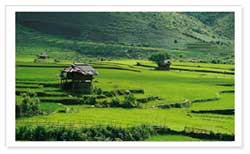 The name Dien Bien Phu will always be linked with battle, for it was here that Viet Minh soldiers overran a French garrison on May 7 th 1954 and ended French colonialism in Indochina. To achieve this legendary victory, Vietnamese forces under the command of General Vo Nguyen Giap dismantled heavy anti-aircraft guns, lugged them up the sleep slopes overlooking the town of Dien Bien Phu and reassembled them. Encircled by artillery, the French could not receive supplies or reinforcements. Today, most visitors who reach this outpost come for the history. But along with the old army headquarters, a museum and monuments, Dien Bien Phu offers pristine mountain scenery and fascinating minority cultures. Those, who go overland will travel through some of Vietnam's most rugged and spectacular mountains. The name Dien Bien Phu will always be linked with battle, for it was here that Viet Minh soldiers overran a French garrison on May 7 th 1954 and ended French colonialism in Indochina. To achieve this legendary victory, Vietnamese forces under the command of General Vo Nguyen Giap dismantled heavy anti-aircraft guns, lugged them up the sleep slopes overlooking the town of Dien Bien Phu and reassembled them. Encircled by artillery, the French could not receive supplies or reinforcements. Today, most visitors who reach this outpost come for the history. But along with the old army headquarters, a museum and monuments, Dien Bien Phu offers pristine mountain scenery and fascinating minority cultures. Those, who go overland will travel through some of Vietnam's most rugged and spectacular mountains.
CENTRAL HIGHLAND
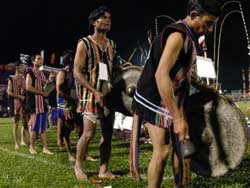 Mysterious lands with numerous tribes Mysterious lands with numerous tribes
Travelers eager to get off the beaten track would be well advised to head for Vietnam's Central Highlands, a remote plateau near the border with Cambodia and Laos.
Along with old-growth forests and pristine rivers, waterfalls and hidden lakes, this region is home to some of the country's most isolated and culturally distinct ethnic minority peoples. Me Thuot, the capital of Dak Lak province, is famous for its coffee plantations. In the surrounding hills, visitors can hike, ride elephants and tour various remote ethnic minority villages. The highland towns of Pleiku and Kon Turn are also gateways to minority villages and long houses. The Central Highlands allow visitors a rare glimpse into the traditional customs of many ancient tribal peoples.
PHAN THIET
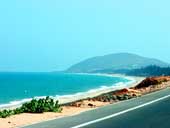 Just a three-hour drive from Ho Chi Minh City, the quiet beach resort of Phan Thiet is a perfect change of pace from modern, city life. A decade ago, this small fishing town received few visitors. Today, you will find an impressive range of international-standard accommodation, various water-sports, and a prizewinning seaside golf course: What hasn't changed is the town's sleepy charm.Visitors can stroll through Phan Thiet's colorful harbors, linger on its long, golden beaches, or explore the nearby 8 th century Cham towers. Just to the east of Phan Thiet lies Cape Mui Ne, a glorious, 21km arc of sand, empty but for towering coconut palms. The palms later give way to a sea of rolling, red sand dunes. Just don't forget your camera: Mui Ne's dazzling blue water, golden sand and red dunes are a photographer's dream. Just a three-hour drive from Ho Chi Minh City, the quiet beach resort of Phan Thiet is a perfect change of pace from modern, city life. A decade ago, this small fishing town received few visitors. Today, you will find an impressive range of international-standard accommodation, various water-sports, and a prizewinning seaside golf course: What hasn't changed is the town's sleepy charm.Visitors can stroll through Phan Thiet's colorful harbors, linger on its long, golden beaches, or explore the nearby 8 th century Cham towers. Just to the east of Phan Thiet lies Cape Mui Ne, a glorious, 21km arc of sand, empty but for towering coconut palms. The palms later give way to a sea of rolling, red sand dunes. Just don't forget your camera: Mui Ne's dazzling blue water, golden sand and red dunes are a photographer's dream.
MEKONG DELTA
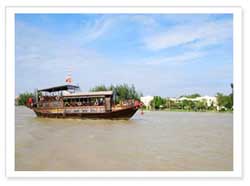 The Mekong River, which begins high in the mountains of Tibet, ends its journey in Vietnam's southern delta. Before flowing into the sea, the river branches into nine tributaries, known as Cuu Long or the "Nine Dragons" . These rivers are the south's life-blood, nourishing the delta's paddy fields and fruit orchards. The Mekong River, which begins high in the mountains of Tibet, ends its journey in Vietnam's southern delta. Before flowing into the sea, the river branches into nine tributaries, known as Cuu Long or the "Nine Dragons" . These rivers are the south's life-blood, nourishing the delta's paddy fields and fruit orchards.
CON DAO ISLAND
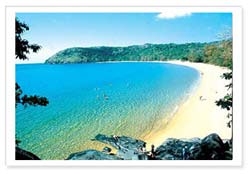 In colonial times, the islands of Con Dao were much feared, as a notorious French prison was located on Con Son, the largest island of this remote southern archipelago. Many of Vietnam's most famous freedom fighters served time on this lonely, windswept island, which lies 185 km south east of the port city of Vung Tau. Today, the archipelago's residents survive by fishing, diving for pearls, collecting swallows' nests, and farming. Visitors will find starkly beautiful cliffs, long, untouched beaches, and patches of thick, old-growth forest. Sea turtles lay their eggs on the islands' remote beaches, while dolphins live offshore. With little in the way of development, Con Dao offers the perfect escape from modern life. In colonial times, the islands of Con Dao were much feared, as a notorious French prison was located on Con Son, the largest island of this remote southern archipelago. Many of Vietnam's most famous freedom fighters served time on this lonely, windswept island, which lies 185 km south east of the port city of Vung Tau. Today, the archipelago's residents survive by fishing, diving for pearls, collecting swallows' nests, and farming. Visitors will find starkly beautiful cliffs, long, untouched beaches, and patches of thick, old-growth forest. Sea turtles lay their eggs on the islands' remote beaches, while dolphins live offshore. With little in the way of development, Con Dao offers the perfect escape from modern life.
CU CHI TUNNEL
 Cu Chi Tunnel is located in the northwest of Ho Chi Minh City. It served as the base for the Vietnamese operation in 1968, known then as the Tet Offensives. This 200km long underground tunnel provided sleeping quarters, meeting rooms, hospitals and social centers. Cu Chi tunnel shows the prolonged resistance war that the Vietnamese people endured and also highlights the national characteristics of determination and ingenuity. Cu Chi Tunnel is located in the northwest of Ho Chi Minh City. It served as the base for the Vietnamese operation in 1968, known then as the Tet Offensives. This 200km long underground tunnel provided sleeping quarters, meeting rooms, hospitals and social centers. Cu Chi tunnel shows the prolonged resistance war that the Vietnamese people endured and also highlights the national characteristics of determination and ingenuity.
|






 HANOI
HANOI Imagine a mystical landscape of turquoise water sprinkled with thousands of jagged, limestone islands. The Halong archipelago is one of the world's natural wonders -a bay with more than 3,000 islands, which time, wind and waves have sculpted into fantastic shapes. The best way to appreciate this magical scene is from a boat, cruising between these karst cliffs, which loom like fairy-tale castles, complete with rocky spires and hidden caves.
Imagine a mystical landscape of turquoise water sprinkled with thousands of jagged, limestone islands. The Halong archipelago is one of the world's natural wonders -a bay with more than 3,000 islands, which time, wind and waves have sculpted into fantastic shapes. The best way to appreciate this magical scene is from a boat, cruising between these karst cliffs, which loom like fairy-tale castles, complete with rocky spires and hidden caves.  In the 1920s, a French visitor to the Imperial City of Hue described the scene as follows: " Perfume-bearers in royal-blue, fan-bearers in sky-blue waving enormous yellow feather fans ,musicians and guardsmen and ranks of mandarins in their curious hats and gorgeous, purple-embroidered dragons, kow-towing down, down on their noses amidst a cloud of incense- and all in a setting of blood-red lacquer scrawled with gold".
In the 1920s, a French visitor to the Imperial City of Hue described the scene as follows: " Perfume-bearers in royal-blue, fan-bearers in sky-blue waving enormous yellow feather fans ,musicians and guardsmen and ranks of mandarins in their curious hats and gorgeous, purple-embroidered dragons, kow-towing down, down on their noses amidst a cloud of incense- and all in a setting of blood-red lacquer scrawled with gold".  Beaming Red Dao women crowd the front steps of Sapa's gothic, grey stone church and pull strips of colorful embroidered fabric from their woven rattan backpacks. Their huge, red headdresses bob as they call to passers-by. Ethnic minority people in various styles of traditional dress -indigo tunics and leggings, elaborate pleated skirts, silver-studded jackets - stroll up from the valley, all bound for Sapa's bustling weekend market. They carry bundles of produce and lead pack-ponies through the village's steep streets.
Beaming Red Dao women crowd the front steps of Sapa's gothic, grey stone church and pull strips of colorful embroidered fabric from their woven rattan backpacks. Their huge, red headdresses bob as they call to passers-by. Ethnic minority people in various styles of traditional dress -indigo tunics and leggings, elaborate pleated skirts, silver-studded jackets - stroll up from the valley, all bound for Sapa's bustling weekend market. They carry bundles of produce and lead pack-ponies through the village's steep streets. Gateway to world Heritages, just a short drive from Danang lay four UNESCO-listed World Heritage Sites: the former imperial city of Hue (2 hours), the ancient ‘Silk Road' trading port of Hoi An (30 minutes away), the spiritual centre of the Champa civilization, My Son (90 minutes) and the mystical Phong Nha Caves in Quang Binh province (3 hours), considered by some an access to the inner earth!
Gateway to world Heritages, just a short drive from Danang lay four UNESCO-listed World Heritage Sites: the former imperial city of Hue (2 hours), the ancient ‘Silk Road' trading port of Hoi An (30 minutes away), the spiritual centre of the Champa civilization, My Son (90 minutes) and the mystical Phong Nha Caves in Quang Binh province (3 hours), considered by some an access to the inner earth!  Geological processes through ages have bestowed upon Viet Nam large area of limestone. Phong Nha - Ke Bang is representative of such a limestone landscape. Located where the majestic Truong Son range starts, Phong Nha-Ke Bang (Quang Binh province) has within it, numerous inter-linking systems of caves, together with a number of very distinctive underground rivers and streams.
Geological processes through ages have bestowed upon Viet Nam large area of limestone. Phong Nha - Ke Bang is representative of such a limestone landscape. Located where the majestic Truong Son range starts, Phong Nha-Ke Bang (Quang Binh province) has within it, numerous inter-linking systems of caves, together with a number of very distinctive underground rivers and streams.  A child with a box of crayons couldn't have created a more colorful place than Nha Trang . Surrounded by steep, dark green hills, the city hugs a long curve of yellow beach and a bay as blue as a fancy cocktail. Everywhere you look there are splashes of color: yellow colonial mansions, red flame trees, the whirling hues of the Ferris wheel and the children's amusement park, vendors selling balloons and beach toys, beach umbrellas in bold, primary colors...
A child with a box of crayons couldn't have created a more colorful place than Nha Trang . Surrounded by steep, dark green hills, the city hugs a long curve of yellow beach and a bay as blue as a fancy cocktail. Everywhere you look there are splashes of color: yellow colonial mansions, red flame trees, the whirling hues of the Ferris wheel and the children's amusement park, vendors selling balloons and beach toys, beach umbrellas in bold, primary colors...  With its green, rolling hills, misty lakes and fragrant pine forests, Dalat is Vietnam's most romantic destination. Set at an elevation of 1,475 metres, surrounded by forests, coffee plantations and gardens, Dalat, is often called the "City of Eternal Spring". The name is apt. While the surrounding lowlands bake in summer heat, Dalat's temperatures hover between a cool 15 and 24 degrees Celsius.
With its green, rolling hills, misty lakes and fragrant pine forests, Dalat is Vietnam's most romantic destination. Set at an elevation of 1,475 metres, surrounded by forests, coffee plantations and gardens, Dalat, is often called the "City of Eternal Spring". The name is apt. While the surrounding lowlands bake in summer heat, Dalat's temperatures hover between a cool 15 and 24 degrees Celsius.  Ho Chi Minh City never sleeps. Everywhere you look there is color and movement. Vendors engulfed in bright bubbles of balloons or pushing carts heaped with wares; flocks of schoolgirls on bicycles, their traditional white ao dai tunics fluttering in the breeze; cranes spinning high overhead as workers put the finishing touches on newly-risen office towers...
Ho Chi Minh City never sleeps. Everywhere you look there is color and movement. Vendors engulfed in bright bubbles of balloons or pushing carts heaped with wares; flocks of schoolgirls on bicycles, their traditional white ao dai tunics fluttering in the breeze; cranes spinning high overhead as workers put the finishing touches on newly-risen office towers...  The name Dien Bien Phu will always be linked with battle, for it was here that Viet Minh soldiers overran a French garrison on May 7 th 1954 and ended French colonialism in Indochina. To achieve this legendary victory, Vietnamese forces under the command of General Vo Nguyen Giap dismantled heavy anti-aircraft guns, lugged them up the sleep slopes overlooking the town of Dien Bien Phu and reassembled them. Encircled by artillery, the French could not receive supplies or reinforcements. Today, most visitors who reach this outpost come for the history. But along with the old army headquarters, a museum and monuments, Dien Bien Phu offers pristine mountain scenery and fascinating minority cultures. Those, who go overland will travel through some of Vietnam's most rugged and spectacular mountains.
The name Dien Bien Phu will always be linked with battle, for it was here that Viet Minh soldiers overran a French garrison on May 7 th 1954 and ended French colonialism in Indochina. To achieve this legendary victory, Vietnamese forces under the command of General Vo Nguyen Giap dismantled heavy anti-aircraft guns, lugged them up the sleep slopes overlooking the town of Dien Bien Phu and reassembled them. Encircled by artillery, the French could not receive supplies or reinforcements. Today, most visitors who reach this outpost come for the history. But along with the old army headquarters, a museum and monuments, Dien Bien Phu offers pristine mountain scenery and fascinating minority cultures. Those, who go overland will travel through some of Vietnam's most rugged and spectacular mountains.  Mysterious lands with numerous tribes
Mysterious lands with numerous tribes  Just a three-hour drive from Ho Chi Minh City, the quiet beach resort of Phan Thiet is a perfect change of pace from modern, city life. A decade ago, this small fishing town received few visitors. Today, you will find an impressive range of international-standard accommodation, various water-sports, and a prizewinning seaside golf course: What hasn't changed is the town's sleepy charm.Visitors can stroll through Phan Thiet's colorful harbors, linger on its long, golden beaches, or explore the nearby 8 th century Cham towers. Just to the east of Phan Thiet lies Cape Mui Ne, a glorious, 21km arc of sand, empty but for towering coconut palms. The palms later give way to a sea of rolling, red sand dunes. Just don't forget your camera: Mui Ne's dazzling blue water, golden sand and red dunes are a photographer's dream.
Just a three-hour drive from Ho Chi Minh City, the quiet beach resort of Phan Thiet is a perfect change of pace from modern, city life. A decade ago, this small fishing town received few visitors. Today, you will find an impressive range of international-standard accommodation, various water-sports, and a prizewinning seaside golf course: What hasn't changed is the town's sleepy charm.Visitors can stroll through Phan Thiet's colorful harbors, linger on its long, golden beaches, or explore the nearby 8 th century Cham towers. Just to the east of Phan Thiet lies Cape Mui Ne, a glorious, 21km arc of sand, empty but for towering coconut palms. The palms later give way to a sea of rolling, red sand dunes. Just don't forget your camera: Mui Ne's dazzling blue water, golden sand and red dunes are a photographer's dream.  The Mekong River, which begins high in the mountains of Tibet, ends its journey in Vietnam's southern delta. Before flowing into the sea, the river branches into nine tributaries, known as Cuu Long or the "Nine Dragons" . These rivers are the south's life-blood, nourishing the delta's paddy fields and fruit orchards.
The Mekong River, which begins high in the mountains of Tibet, ends its journey in Vietnam's southern delta. Before flowing into the sea, the river branches into nine tributaries, known as Cuu Long or the "Nine Dragons" . These rivers are the south's life-blood, nourishing the delta's paddy fields and fruit orchards.  In colonial times, the islands of Con Dao were much feared, as a notorious French prison was located on Con Son, the largest island of this remote southern archipelago. Many of Vietnam's most famous freedom fighters served time on this lonely, windswept island, which lies 185 km south east of the port city of Vung Tau. Today, the archipelago's residents survive by fishing, diving for pearls, collecting swallows' nests, and farming. Visitors will find starkly beautiful cliffs, long, untouched beaches, and patches of thick, old-growth forest. Sea turtles lay their eggs on the islands' remote beaches, while dolphins live offshore. With little in the way of development, Con Dao offers the perfect escape from modern life.
In colonial times, the islands of Con Dao were much feared, as a notorious French prison was located on Con Son, the largest island of this remote southern archipelago. Many of Vietnam's most famous freedom fighters served time on this lonely, windswept island, which lies 185 km south east of the port city of Vung Tau. Today, the archipelago's residents survive by fishing, diving for pearls, collecting swallows' nests, and farming. Visitors will find starkly beautiful cliffs, long, untouched beaches, and patches of thick, old-growth forest. Sea turtles lay their eggs on the islands' remote beaches, while dolphins live offshore. With little in the way of development, Con Dao offers the perfect escape from modern life.  Cu Chi Tunnel is located in the northwest of Ho Chi Minh City. It served as the base for the Vietnamese operation in 1968, known then as the Tet Offensives. This 200km long underground tunnel provided sleeping quarters, meeting rooms, hospitals and social centers. Cu Chi tunnel shows the prolonged resistance war that the Vietnamese people endured and also highlights the national characteristics of determination and ingenuity.
Cu Chi Tunnel is located in the northwest of Ho Chi Minh City. It served as the base for the Vietnamese operation in 1968, known then as the Tet Offensives. This 200km long underground tunnel provided sleeping quarters, meeting rooms, hospitals and social centers. Cu Chi tunnel shows the prolonged resistance war that the Vietnamese people endured and also highlights the national characteristics of determination and ingenuity.